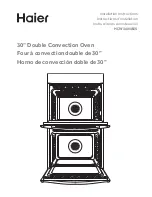
Preventing material damage
en
7
2 Preventing material damage
2.1 General
ATTENTION!
Objects on the cooking compartment floor at over
50 °C will cause heat to build up. The baking and
roasting times will no longer be correct and the enamel
will be damaged.
▶
Do not place any accessories, greaseproof paper or
foil of any kind on the cooking compartment floor.
▶
Only place cookware on the cooking compartment
floor if a temperature above 50 °C has been set.
When the cooking compartment is hot, any water in-
side it will create steam. The change in temperature
may cause damage.
▶
Never pour water into the cooking compartment
when it is still hot.
▶
Never place cookware containing water on the
cooking compartment floor.
The prolonged presence of moisture in the cooking
compartment leads to corrosion.
▶
Allow the cooking compartment to dry after use.
▶
Do not keep moist food in the cooking compartment
for a long time with the door closed.
▶
Do not store food in the cooking compartment.
Leaving the appliance to cool down with the door open
will damage the front of neighbouring kitchen units over
time.
▶
Always allow the cooking compartment to cool
down with the door closed after cooking at high
temperatures.
▶
Take care not to trap anything in the appliance
door.
▶
Only leave the cooking compartment to dry with the
door open if a lot of moisture was produced during
operation.
Fruit juice dripping from the baking tray leaves stains
that cannot be removed.
▶
When baking very juicy fruit flans, do not pack too
much on the baking tray.
▶
If possible, use the deeper universal pan.
Using oven cleaner in a hot cooking compartment
damages the enamel.
▶
Never use oven cleaner in the cooking compartment
when it is still warm.
▶
Remove all food remnants from the cooking com-
partment and the appliance door before you next
heat up the appliance.
If the seal is very dirty, the appliance door will no
longer close properly during operation. This may dam-
age the front of adjacent kitchen units.
▶
Keep the seal clean at all times.
▶
Never operate the appliance if the seal is damaged
or missing.
Sitting or placing objects on the appliance door may
damage it.
▶
Do not place or hang objects on the appliance door.
▶
Do not place cookware or accessories on the appli-
ance door.
With certain models, accessories may scratch the door
pane when closing the appliance door.
▶
Always push accessories fully into the cooking com-
partment.
2.2 Microwave
Follow these instructions when using the microwave.
ATTENTION!
Metal touching the wall of the cooking compartment
will cause sparks, which may damage the appliance or
the inner door pane.
▶
Metal (e.g. a spoon in a glass) must be kept at least
2 cm from the cooking compartment walls and the
inside of the door.
Using accessories directly on top of one another
causes sparks.
▶
Do not combine the wire rack with the universal
pan.
▶
Always place accessories on different levels.
The universal pan and baking tray are not suitable for
use with microwave-only mode. Using either of these
may create sparks, which will damage the cooking
compartment.
▶
Place accessories on the wire rack supplied.
Placing aluminium containers in the appliance may
cause sparks, which will damage the appliance.
▶
Do not use aluminium containers in the appliance.
Operating the appliance without food in the cooking
compartment may lead to overloading.
▶
Do not switch on the microwave unless there is food
inside. The only exception to this rule is when per-
forming a short cookware test.
If you prepare microwave popcorn at a microwave
power level that is too high, the door pane may crack
due to overloading.
▶
Never set a microwave power level that is too high.
▶
Use a maximum microwave output of 600 watts.
▶
Always place the popcorn bag on a glass plate.








































